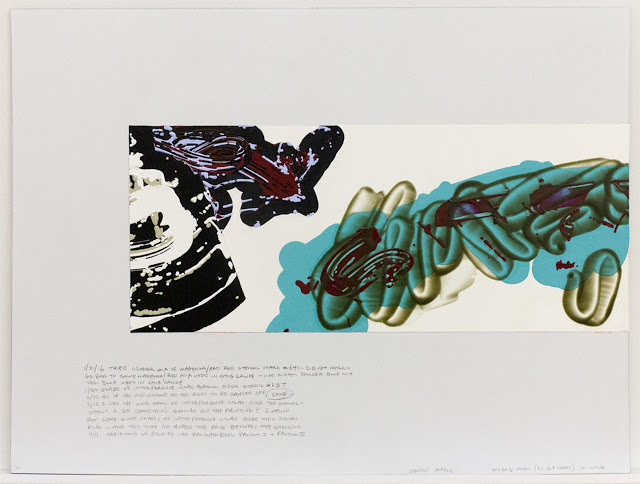At Peter Blum, the looping brushstrokes and open surfaces of David Reed�s remarkably spare site-specific installation are anything but casual. Entering the gallery, the viewer is faced with a 40-foot long multi-panel horizontal piece along the far wall. From a distance, it�s easy to imagine an old-school action painter laying down what seem to be curving, dripping strokes in a kind of improvised calligraphy. On closer inspection, however, it becomes apparent that some of the �brushwork� is created by means of laser-cut stencils. Like Roy Lichtenstein, Reed is presenting a fictitious interpretation � in this case, a facsimile of gestural abstraction. Like a movie, Reed�s painting speaks of lived experience but isn�t real.
[Image at top: David Reed, installation at Peter Blum.]
In the back room, a series of 16 x 20-inch thin aluminum panels that simulate working studies are propped on long rail shelves against the wall. Each has notes, seemingly handwritten, on the bottom that explain all the different stages of production that the individual panels in the front room went through. Careful inspection of the four different variations of the piece reveals that Reed, who famously loves film, has borrowed a technique from filmmaking. By sanding the larger panels down, reworking them, and then assembling them into the final piece, Reed is able to stop time and improve upon reality. Like a filmmaker, he seems to create magical effects effortlessly and these panels tell viewers how he does it.
In the front room, on the opposite wall from the big painting installation, is a large framed drawing from 1975. The image consists of two long, wide, black brushstrokes on photographic backdrop paper, each bordered with a hand-drawn rectangular pencil line. To my eye, this drawing looks like a study, perhaps a plan Reed made as a young artist for a future painting. Indeed, the same two lines are prominently featured � they are the stars! � in the painting on the opposite wall.
Hung in the same gallery, the new multi-panel piece and the 1975 drawing � made 45 years apart � establish a deeply moving intra-personal dialogue about aging, learning, authenticity, and memory. That is, Reed is documenting the relationship between the authentic but crude expression of his younger self and the sophisticated self-awareness that comes with age and experience. More broadly, the installation could be read as a reiteration of the familiar argument that all innovation has been exhausted, and that the best contemporary painters can do is to riff and noodle on past styles without discovering anything new. But I don�t think Reed intended the project as this sort of cool postmodern exercise. Rather, while he acknowledges that the debate may pose an ongoing challenge to painters, he elegantly asserts that when seen as a metaphor for the artist’s life, his process has rich meaning beyond the conversation about art.
�David Reed, New Paintings,� Peter Blum, midtown, New York, NY. Through June 25, 2016
Related posts:
Rejecting the New: Abstract painting in the 1980s 2013)
Quote of the Day: David Reed on drawing (2010)
Yau on Reed (2007)
——
Two Coats of Paint is licensed under a Creative Commons Attribution – Noncommercial-No Derivative Works 3.0 United States License. To use content beyond the scope of this license, permission is required.























Thanks for posting your article. I am curious about his stencils. You mentioned they are laser cut. Are all of his stencils laser cut? Please describe in more detail your observation about his stencils.
I recently saw some of his paintings and work in progress notes at the Perez Museum in Miami. I noticed he referenced his use of stencils many times in his notes. In fact, in one instance he said a stencil “fractured.” What kind of material is/was used for the stencil to fracture? Does he use any stencils that are cut from bristol board? I thought he maybe used thick bristol board. I look forward to a reply.